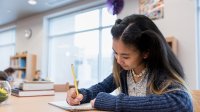The Benefits of Student Reflections Early in the Year
Thoughtfully assessing their progress allows middle school students to make adjustments in order to achieve their academic goals.
Your content has been saved!
Go to My Saved Content.Like many teachers, I value student feedback as an essential way to create an engaging environment and ensure that my students are valued.
A few years into my career, I had an interesting turn of events. A number of my students interpreted questions on my feedback form in a different way than intended: When they read, “What is something you’d like to see change?” they assumed that I was talking about them. Instead of providing ideas for my class, they provided reflections on what they wanted to do differently. It not only was a good reminder to write clear instructions and questions, but also provided me with important insight into how they saw their work in my class.
I had often used end-of-the-year reflections. After this fortuitous mix-up with my students, though, I was reminded of how important it is to not only ask for feedback—which I still do—but also give my students the opportunity to reflect on their own work early in the year.
Reflecting on Work Encourages Metacognition
Using student reflections early in the year can provide important information while there’s still time to change course. It also helps students practice metacognition, the process of thinking about the way we think. When we ask our students to reflect on their study habits, workflow, and capabilities, they can make connections between practices that work—like asking a friend to quiz them or drawing their notes—and what they may want to let go.
This is valuable for our students who might be struggling academically or socially; they can reflect and reconsider practices that they might want to change or that allow them to see places where they may need to ask for help or be open to support. The process is also valuable for stronger students who can consider any changes they may need to make and celebrate their success. This creates a sense of pride in their work that is powerful for our students to see early on.
Reading student reflections also provides me with understanding of my students’ needs, thoughts, and goals. I learn what they carry outside my classroom and get a peek into how they see themselves. I had a student who was struggling, yet their reflection revealed their pride in how much they had improved from the year before. It was an important reminder that each student is coming to my classroom at different points in their journey and that I can support them and celebrate their progress.
3 Effective Methods of Reflection
1. A survey. The survey is a classic for a reason: it’s relatively easy to set up, allows you to ask a number of specific questions, and can be done in a shorter amount of time. I’ll set aside the first or last 20 minutes of class for students to reflect. If the survey is online, it’s even easier to look at data and we can look at responses in many ways, such as a word cloud. Google Forms is a commonly used way to collect responses. Here’s an example of one I’ve used.
An important note: It’s important to ensure that the questions we ask are helpful and provide a safe space to reflect. Effective questions that provide clear parameters and require more than a few words to respond to (e.g., “What are two things that helped you learn this quarter?”) are positive in tone and can help students provide meaningful reflections. I avoid questions that ask, “What went wrong?” as it can feel judgmental. Instead, I ask them to consider, “What will help you thrive?” or “How can you help yourself achieve?” I asked teachers for examples of questions they used online and got some great ideas.
2. A letter. Students write a letter to themselves, though I’ve seen examples where they write the letter to a teacher or friend. I love this method for a number of reasons. First, it provides a more open and free-form space to allow students to explore their ideas and beliefs about their work. You can provide the same questions that you might use in a survey to get them thinking, but the letter format ultimately lets them organize their thoughts more organically. This activity is useful for me to see what my students value and focus on in their writing. Additionally, it also provides a more casual writing sample to get a sense of their voice and fluency in a low-stakes format. Finally, it’s a nice venue to teach the letter-writing format to students.
3. A vision board. Vision boards are typically ways for us to visually process our goals and ideas for the future, though they can easily include more reflective questions. Vision boards can be powerful tools to help students visualize what success actually looks like for them, both academically and outside of their school lives. These visualizations can help them make deeper connections to their goals and the work they need to do. Plus, they are fun to do and share with each other! I always include a link to my own.
Once the school year gets going, many teachers feel the days go quickly and they’re just trying to keep up. No doubt, our students feel similarly. While it may feel impossible to pause, taking a moment to stop, breathe, and look around can help us make sure we’re heading down the best path. In slowing down, we can make sure we get all the tools we need to get ahead.
